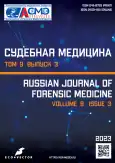确定15岁以上个体的步态周期与速度之间的关系
- 作者: Kosukhina O.I.1, Fomina E.E.2, Leonov S.V.1,3
-
隶属关系:
- Moscow State University of Medicine and Dentistry named after A.I. Evdokimov
- Tver State Technical University
- Chief State Center for Forensic Medicine and Forensic Expertise 111
- 期: 卷 9, 编号 3 (2023)
- 页面: 279-286
- 栏目: 原创研究
- URL: https://journals.rcsi.science/2411-8729/article/view/148353
- DOI: https://doi.org/10.17816/fm12646
- ID: 148353
如何引用文章
全文:
详细
论证。在使用视频监控和固定摄像机的数据时,人的识别问题是要解决的实际任务之一。如果无法通过脸部识别一个人,步态识别就变得非常重要。
该研究的目的是确定步态周期,作为识别个人步态的参数之一。
材料与方法。作者开展了一项由92名受试者参与的单中心随机非对照观察研究。这项研究的成果是注册的《步态周期特征数据库》(国家注册证号:2022623085)。研究的主要终点是确定个体的步态周期与速度之间的关系。评估是采用非参数斯皮尔曼相关标准进行的。
结果。对获取数据的比较分析表明了,随着个人速度的增加,所有步态周期(第一和第二双支撑步态周期、第一和第二迁移步态周期)都会逐个缩短。
结论。所获取的数据允许利用步态周期的特征来识别个人(按不同速度行走时的步态)。这一步可有助于进一步开发个人步态识别算法,作为个人身份识别的参数之一。
作者简介
Oksana I. Kosukhina
Moscow State University of Medicine and Dentistry named after A.I. Evdokimov
Email: u967nk@yandex.ru
ORCID iD: 0000-0003-1665-3666
SPIN 代码: 7794-6782
MD, Cand. Sci. (Med.)
俄罗斯联邦, MoscowElena E. Fomina
Tver State Technical University
Email: f-elena2008@yandex.ru
ORCID iD: 0000-0002-1028-0750
SPIN 代码: 6602-8570
Cand. Sci. (Engin.), Assistant Professor
俄罗斯联邦, TverSergei V. Leonov
Moscow State University of Medicine and Dentistry named after A.I. Evdokimov; Chief State Center for Forensic Medicine and Forensic Expertise 111
编辑信件的主要联系方式.
Email: sleonoff@inbox.ru
ORCID iD: 0000-0003-4228-8973
SPIN 代码: 2326-2920
MD, Dr. Sci. (Med.), Professor
俄罗斯联邦, Moscow; Moscow参考
- Zinin AM. Actual problems of forensic portrait examination. Bulletin Economic Security. 2018;(1):64–66. (In Russ).
- Mikhailova MS. Individual issues of portrait examination within the framework of forensic research. Int J Humanities Natural Sci. 2019;(11-3):74–76. (In Russ). doi: 10.24411/2500-1000-2019-11818
- Shakiryanova YP. The value of general anatomical elements of appearance when identifying a person by digital video recording. Bulletin Med Institute “REAVIZ”: rehabilitation doctor health. 2018;(1):89–93. (In Russ).
- Urusova IE. Study of the possibility of using methods of personal identification by gait characteristics based on the analysis of video flow in UIS institutions. In: Actual issues of informatization of the Federal Penitentiary Service at the current stage of the development of the penal system: A collection of round table materials; 2018 Oct 19. Tver, 2018. (In Russ).
- Bulgakov VG, Bulgakova EV. Features of the method of forensic examination of dynamic signs of human gait. Forensic Examination. 2013;(4):23–31. (In Russ).
- Bashir Kh, Xiang Т, Gong G. Gait Recognition using Gait Entropy Image. School Electronic Engineering Computer Science. Queen Mary University London United Kingdom. 2010;76(2):21–23. doi: 10.1049/IC.2009.0230
- Marsico MM, Proença NH. Human recognition in unconstrained environments. Using Computer Vision, Pattern Recognition and Machine Learning Methods for Biometrics; 2017.
- Wan Ch, Wang L, Phoha V. A survey on gait recognition. Southeast University Chine. 2018;70(3):34–35. doi: 10.1145/3230633
- Saydamarova VV. Theoretical study of foreign experience in personal identification by video. In: Problems and prospects for improving legislation and law enforcement practice of internal affairs bodies: Materials of an international remote scientific and practical conference; 2020 Oct 30. Karaganda; 2020. Р. 163–167. (In Russ).
- Shenderov VA. Biomechanical examination: identification of individual features of gait and posture during personality identification. Russ J Biomechan. 2007;11(2):75–78. (In Russ).
- Skvortsov DV. Clinical and biomechanical analysis of the pathological gait through the hardware and software complex [dissertation abstract]. Moscow; 1997. 23 р. (In Russ).
- Skvortsov DV. Clinical analysis of movements. Gait analysis. Ivanovo: Stimul; 1996. 344 р. (In Russ).
- Patent RUS No. RU 2022623085. Kosukhina OI, Fomina EE, Leonov SV. Database of characteristics of the step cycle. (In Russ). Available from: https://elibrary.ru/bilebd. Accessed: 15.08.2023.
补充文件









